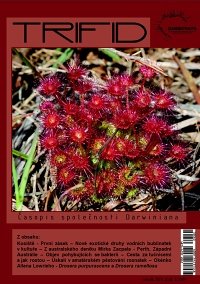Trifid 2009/1
New exotic species of bladderworts in culture
Lubomír Adamec
At the begining the author corrects the fact written previously that U. reflexa from the central part of tropical Zambia can have 1,5 to 2 cm big traps. Although the conditions were most favourable and plants were growing extremely well, the biggest traps were only 7 mm big, so the claim was unfounded. Then the article tells about the species U. cymbantha (the African bladderwort) liking of warm and light conditions, followed by U. muelleri which seems to be the easiest of the trio to grow and finishing off with the Australian U. arnhemica which is a surprising teaser. Contrary to popular belief it is more at home in cool and shady conditions. In culture, it is only possible to grow it terrestrially although it is an aquatic to amphibious bladderwort. The author’s assumption is that it is so sensitive to quantity of oxygen in water that it cannot live in a stagnant pool.
Mirek Zacpal's Australian diary – Perth, Western Australia
Mirek Zacpal
The author who is on a prolonged sojourn in Australia undertook a seven day trip to outskirts of Perth. There is no doubt that it is a tuberous sundews paradise. He saw D. zonaria, D. platypoda, D. gigantea 'red form' as well as bladderworts (U. menziesii), Cephalotus follicularis and a number of other botanical curiosities such as orchids. Considering that his guide was Allen Lowrie, it's easy to see why Mirek did not miss a single species from these locations.
Moving bacteria discovery
Tomáš Báborský
When you get a microscope, don't hesitate to explore! Tom's article is the proof that young researcher's mind’s potential has no limits.
Some notes to Tom's article
Zdeněk Žáček
Zdeněk with all the available sources of specialized literature at hand and his depth of knowledge helps Tom clarify some of the mysteries that micro-world has to shows.
I don't like bacteria
Michal Kouba
Bacteria is in an word omnipresent. They can help us as well as hurt us. Experienced growers of plants with in vitro method are of course terrified by the thought of a single bacteria in a sterile medium. And sometimes it becomes a nightmare…
Interinfo
Society life: An invitation to the General Meeting which will take place on Saturday 13. 6. 2009 at the glasshouse in the Faculty of Science at the Jan Evangelista Purkyně University in Ústí nad Labem (Za Válcovnou 1000/8). The meeting will start at 10:00 and at 14:00 there will be a lecture by Jaroslav Neubauer.
What is interesting in the Liberec Botanical Garden?
Blanka Syrovátková
Thanks to the author we can learn something about the gardens, what is new and coming up soon. Which is a pity because spring is just around the corner. So you can go and see for yourself.
A journey to meet butterworts and see how they grow – Part 1
Jaroslav Neubauer
Experienced traveller starts off this year’s series with a journey to visit the butterworts of Spain. He did of course meet many other carnivorous plants and orchids on the way. The journey starts in Switzerland: A. vesiculosa, S. purpurea and P. grandiflora. Continuing on to France and to see S. purpurea, S. flava, P. grandiflora, P. vulgaris, P. alpina and in the Canyon Tarn P. longifolia subsp. causensis. Then it leads us to Andorra and finally to Spain where we meet P. dertosensis and we look forward to Rio Mundo and P. mundi.
An amateur growing of sundews, its difficulties, solutions and ways to succeed
Lucie Bartoňová
This article is proof that sometimes we want to improve conditions for our plants but paradoxicaly they cannot understand. Then it takes a lot of work convincing them that they should grow better. And later explain to troublesome moss that it has to grow somewhere else.
Allen Lowrie's window
Allen Lowrie (transalated by Zdeněk Žáček)
Australia is a real paradise of tuberous sundews. In this part of the series the author gives us a precise description of D. purpurascens from Stolonifera section with perfect schematic drawings. It grows close to D. porrecta and D. stolonifera. The next tuberous sundew from Stolonifera section which the author describes to us in detail is D. ramellosa. This species grows frequently on granite ledges and by stream and lake shore. Both these sundews are quite characteristic – D. purpurascens by its trumpet shape of leaves blade and D. ramellosa with its two main stalks (ramellosa = more branches).
Where does Mája the bee live?
Michal Rubeš
The well known TV series of this bee hero made Mája a celebrity. In one of the series parts the author noticed an important clue to finding out where she lives. There was an interesting butterwort on the camera. The flower has a distinctive colour! Enjoy this piece of humor!
